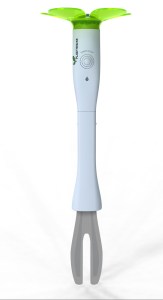
The company is also announcing today that is has raised $3.5 million in a first round of funding from Gabriel Ventures and angels. The company makes a sensor tool which has a USB connector. After you plug it into the ground for 24 hours, you take the connector and plug it into a PC or Mac.
[aditude-amp id="flyingcarpet" targeting='{"env":"staging","page_type":"article","post_id":93686,"post_type":"story","post_chan":"none","tags":null,"ai":false,"category":"none","all_categories":"business,","session":"A"}']The PlantSense software reads the data on the soil, sunlight, humidity, and the soil’s ability to hold water. It uploads the data to the web site and then recommends which plants will thrive in that soil. You can also diagnose what is going wrong with a plant that isn’t doing well. The device will be launched later this year for year-round garden use.
PlantSense’s chief executive is Matthew Glenn, a six-time entrepreneur whose last big hit was the wireless startup Airespace, which Cisco bought in 2005 for $425 million.
AI Weekly
The must-read newsletter for AI and Big Data industry written by Khari Johnson, Kyle Wiggers, and Seth Colaner.
Included with VentureBeat Insider and VentureBeat VIP memberships.
He got the idea from a conversation he had with a couple of hair stylists about why a plant couldn’t survive in a nearby spot.
“I had a light bulb moment about how you could get sensors and use an algorithm to figure out what plant could grow in a particular location,” Glenn said.
He went to his local Home Depot and couldn’t find anything that did the job. He then talked to a bunch of scientists about how to fashion the horticulture advice. There are, however, more sophisticated devices used on farms and vineyards, using sensors from companies such as Rapid Test.
Glenn said he soon learned that most Americans are frustrated with gardening. Americans spend $21 billion annually on plants but a third of those die within a year. Figuring out what to plant and where is often a process of trial and error.
The company licensed the same soil technology that NASA used for the latest soil sensor on one of the Mars landers. The advice is detailed enough so that it can explain your home’s “micro climates.” That is, it can tell you why a plant will thrive in one spot but won’t thrive a few yards away. The list price for the device, which has off-the-shelf sensors and a microprocessor, is $59.95. The target is ordinary consumers, not sophisticated growers.
“Our biggest problem will be that there is nothing like it on the market yet,” he said. “We have to educate consumers.”
[aditude-amp id="medium1" targeting='{"env":"staging","page_type":"article","post_id":93686,"post_type":"story","post_chan":"none","tags":null,"ai":false,"category":"none","all_categories":"business,","session":"A"}']
The internet is coming to everyday objects, thanks to sensors, networking and cheap computing. Glenn thought about using wireless technology but decided that most Wi-Fi networks couldn’t reliably reach into gardens around homes.
Glenn started the company in San Francisco in 2005 with David Wilkins, chief technology officer. The company plans a beta test soon through its web site. It will use the funding for product development, operations, production and marketing. Glenn funded the startup until now on his own. The company has six patents to date.
VentureBeat's mission is to be a digital town square for technical decision-makers to gain knowledge about transformative enterprise technology and transact. Learn More
